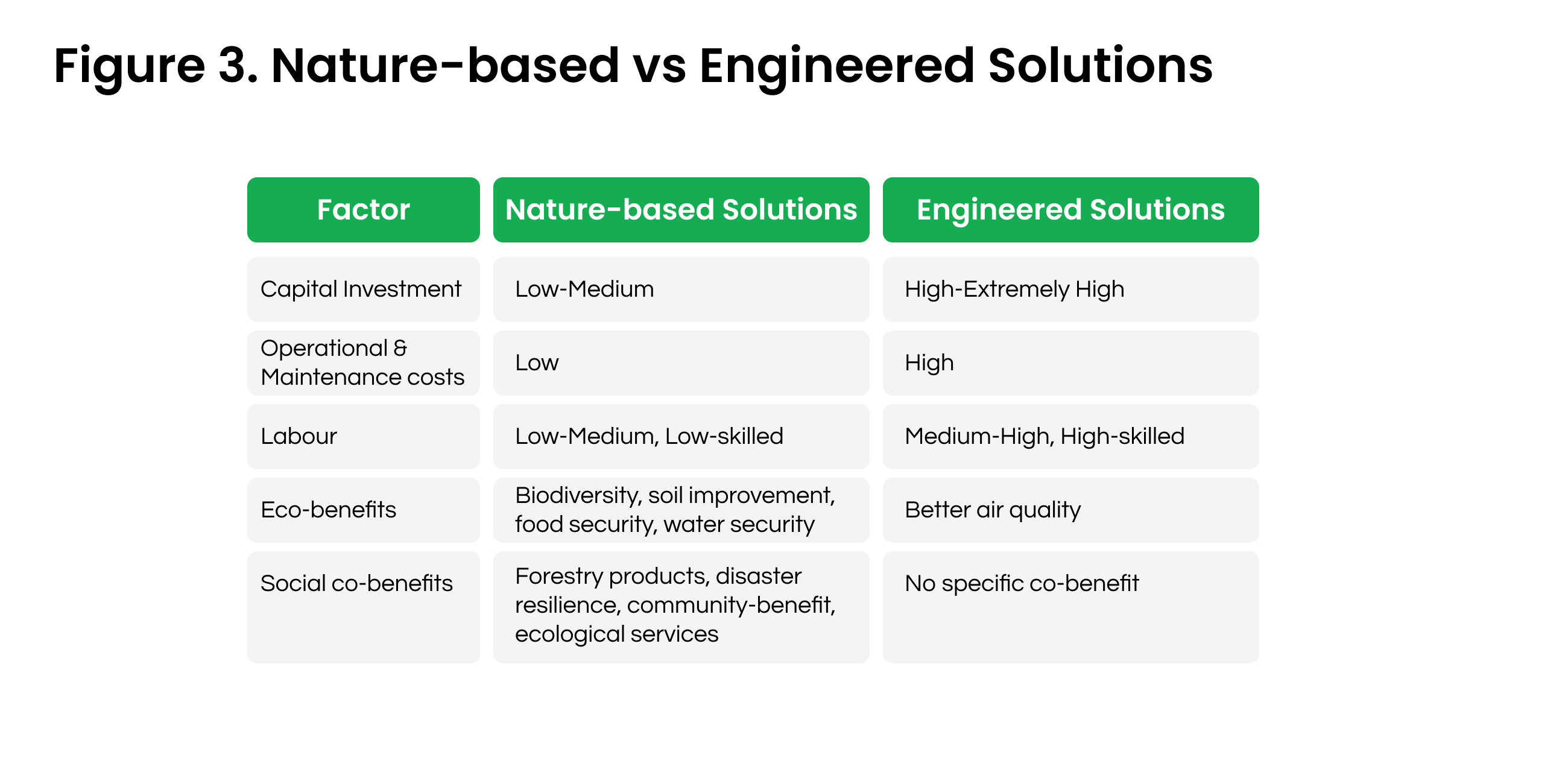The Business Guide to Nature-based vs. Engineered Solutions

Organisations across the globe are looking for solutions to reduce and mitigate their negative climate impacts. Amongst the different options to manage greenhouse gases, today we'll focus on:
- Nature-based Solutions (NbS) - which are cost-effective and community-oriented;
- Engineered Solutions (ES) - which rely on technological innovation.
-png.png)
Setting the scene
In the last 250 years, since the Industrial Revolution, human activities have been generating deep impacts on natural ecosystems. Fossil fuels have a big role to play in that. Our economies have been relying deeply on them, as they advanced our standards of living.
Yet, as the old saying goes, “Every hole you dig leaves a mound of dirt behind you”. Our mound is now beginning to have real-world consequences:
- Global warming;
- Rising sea levels;
- Unprecedented weather events;
- And many other social implications.
Both the UNFCCC and the Paris Agreement stressed the importance of the collective effort to halt climate change.
Climate-conscious organisations across the world are better understanding their impacts. As a result, they are aligning their climate strategies to the ambitious Net-Zero targets set out by the Paris Agreement.
Despite the efforts to reduce emissions and align to the Net-Zero path, all commercial activities are energy and resource intensive. Therefore, they still generate hard-to-abate greenhouse gas emissions.
Residual emissions can be addressed by neutralising them. This means supporting initiatives and projects through which removing an amount of carbon from the atmosphere equivalent to residual emissions.
Organisations can achieve this either through internal initiatives or offsetting. This article takes a quick dive into the two main approaches to offsetting – Nature-based Solutions (NbS) and Engineered Solutions (ES).
What do these terms mean?
You need to understand the climate jargon to successfully formulate, implement and communicate your climate strategy.
In this article, you have already encountered terms such as Net-Zero, neutralisation, and offsetting. They are often (mistakenly) used interchangeably or in similar contexts.
- Net-Zero refers to a balance between emissions from human activities and the removal from the atmosphere by various ‘sinks’. On an organisational level, the reduction of emissions is followed by the complete neutralisation of residual GHGs using ‘like-for-like’ removals. This means that once as many emissions as possible are reduced, the organisation removes the remaining emissions in a manner proportional to the timescale (see ‘Neutralisation’ below).
- Neutralisation/Offsetting refers specifically to the act of retiring purchased carbon credits from climate mitigation projects which remove GHG from the atmosphere.
- Credits refer to a transactional instrument which represents 1 metric ton of all GHG emissions. Simply put, it is a unit of measure for neutralisation. This means that purchasing a credit compensates for an equal amount of emissions from an organisation. The credit is retired after purchase to avoid double counting on the credit developer and purchaser’s inventory.
Nature-based solutions (NbS)
NbS are the most popular technology for removing carbon. Such projects aim to restore nature's carbon sinks. Nature-based methodologies help breathe new life into the natural carbon cycle. As a result, storing CO2 in plants and soil. Examples include reforestation, mangrove forestation, ecosystem restoration, and soil improvement.
These low-risk interventions require very little external maintenance and are often affordable by even SMEs. After all, photosynthesis continues to be the cheapest, most efficient option to capture carbon dioxide (CO2) from the atmosphere. Moreover, according to estimates, NbS can provide over 1/3 of all climate mitigation required by 2030.
NbS pose significant ecological benefits. Every component of an ecosystem is often multifunctional. For example, trees not only remove CO2 but also host many species of flora and fauna. Because of that, they have positive consequences on the environment, such as increasing biodiversity and soil nutrition.
Biodiversity enhances ecological resilience and the storage of carbon in the soil. They play an important part in the natural carbon cycle. In fact, diverse plants:
- Bind soil and reduce soil erosion;
- Improve soil and water quality;
- Stimulate soil productivity.
-png-2.png?width=906&height=453&name=Figure%202-%20Carbon-cycle%20diagram%20(5)-png-2.png)
Interestingly, NbS also present many social advantages. Timber & forestry are significant activities for the livelihoods of local communities. From them, we derive various products such as lumber, firewood, honey, exotic fruits & nuts, resins, and rubber.
Ecosystems also provide social services, such as food and water security, together with opportunities for ecotourism.
Sustainably managing forests is a community effort, which brings multiple stakeholders closer to nature. For instance, the TIST Smallholder Reforestation project has planted over 20 million trees by engaging with more than 100.000 farmers in India and East Africa. Other prominent examples are the Rukinga REDD+ project, in Kenya and Luangwa Community Forests project, in Zambia.
Challenges of NbS
NbS are difficult to quantify.
For example, the carbon absorbed by reforested areas is measured following simplified methodologies. The carbon in each tree is estimated based on tree volume and species. This is then extrapolated to estimate the carbon stored in the roots and the plant. Such assumptions increase estimation errors while ignoring other carbon sinks in the system, such as leaves and the soil.
While offset programmes prefer to take conservative estimates, the errors can be quite large and not highly representative of the actual offsets achieved.
Another issue affecting NbS is reliability. By investing in an NbS, organisations bet on long-term performance, usually over decades. This factor is known as permanence. If an NbS is executed in an area where its permanence is at-risk then the point of offsetting is lost.
This explains why careful due diligence on offset projects is recommended before investing. Practically, methodologies of leading programmes such as Verified Carbon Standard (VCS) undergo rigorous peer review and are good barometers of authenticity.
Engineered Solutions (ES)
Through ES, organisations can achieve either carbon avoidance or removal. Renewable power and fuels, and energy efficiency innovations avoid carbon emissions. However, these mechanisms do not represent tangible ‘savings’, as they are instead accounting estimations.
Many avoidance technologies available today are easily scalable, such as wind turbines and electric vehicles. With renewables being cheaper than fossil fuels in many countries already, these technologies are also becoming a better financial option.
On the other hand, removal mechanisms directly capture carbon as it is emitted, or from the atmosphere and oceans. In contrast to avoidance mechanisms, removal mechanisms either chemically, electrically, or mechanically absorb carbon to store it.
The most prominent removal technology is the Direct Air Carbon Capture & Storage (DACCS or CCS) System. The UK Government, for instance, conducts a Direct Air Capture and other Greenhouse Gas Removal Technologies competition to fund development. The first large-scale DACCS system will be operational in the US by 2024.
Challenges of ES
ES are newly developed technologies. At this scale, it takes significant resources to develop and maintain ES. The capital investment alone for a DACCS system may be hundreds or thousands of times higher than a comparably performing NbS.
Additionally, ES offer very few benefits since it focuses only on carbon removal. This means that synergetic activities with environmental action and commitments are harder to achieve.

How can businesses contribute?
The post-pandemic era has seen rapid growth in global carbon trading. The voluntary carbon market (VCM) market reached $2B in 2021, quadrupling in size from 2020. Trading volumes from NbS solutions have seen a marked increase, commanding higher prices for projects with social and environmental benefits. This is a milestone, showing that organisations are increasingly opting for co-benefits alongside offsetting.
Moreover, with over 170 types of credits from 100 countries on offer now, VCMs have spread and increased in complexity. This is great news for the industry, and for local communities that benefit from these projects. That said, organisations must opt for offsets only to neutralise unabated emissions and not as an alternative to carbon reduction.
As transparency and integrity are leading concerns, the quality of offset programmes has a strong reputational value for organisations. Together with this, there is a growing call for publicly verifiable compliance and quality data. International regulatory mechanisms aim to tie the VCMs to the standards expected by the Paris Agreement.
Businesses can support NbS and ES projects throughout their entire value chain. This can be done by connecting with brokers, vendors, and potential developers to accelerate project scouting, development, and trading. Working with value chain partners can bring many more projects to the market and provide added benefits to the local communities involved.
The crucial concern is whether such a pipeline can improve upon the quality of offsets developed while also increasing the speed of development and access. Industry associations can play a key role in awareness. Some ideas to achieve that are:
- Hosting workshops and conferences;
- Setting industry guidelines or recommendations;
- Fostering collaborations with all members of the value chain.
What should my organisation invest in?
NbS and ES are no one-size-fits-all solutions. It is quite subjective to the purchasing organisation. The foremost consideration to take is the authenticity of the offsets.
Organisations can carry out due diligence on the project developers, vendors, and offset programmes. Such checks can focus on:
- Certifications;
- Collaborations;
- Quality standards;
- Accreditations;
- Participation in alliances;
- Other aspects that indicate quality and reliability.
Additionally, organisations can conduct a high-level risk assessment to determine the permanence of offsets.
A second, very important consideration is whether the offsets match the identity of the organisation. An electric battery manufacturer may find better synergy by investing in ES. However, a marine logistics organisation may be closer to Blue Carbon NbS projects. Some projects come with co-benefits that may fit the organisation’s social engagement strategy as well, which can help integrate and consolidate actions and communication.
Offsets are the last recommended steps in the scale and scope of possible climate actions. Achieving carbon reductions is the priority, with offsets only to neutralise emissions that cannot be reduced. The number of offsets to purchase should be determined through carbon footprint or life-cycle analyses.
It is critical to recognise offsets as a solution, not the solution, with benefits and pitfalls. Yet, they form a crucial mechanism that helps nudge organisations and communities in developing countries towards the triple bottom line. After all, the idea behind offsets is indeed that of balance.
“With the world's human population now at seven billion and growing, and the demand for technology and modern conveniences increasing, we can't control all our negative impacts. But we must find better ways to live within the limits nature and its cycles impose.”
- David Suzuki